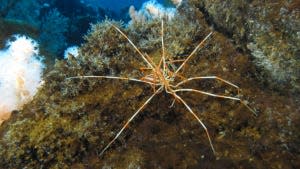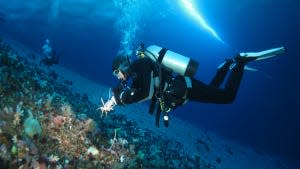After 140 years, researchers finally learn how giant sea spiders in Antarctica reproduce
Sea spiders may be relatively large and found in abundance in Earth's oceans, but little remains known about the mysterious marine creatures.
An understanding of the reproductive habits of giant sea spiders in Antarctica, for instance, has eluded marine biologists ever since the species was discovered more than 140 years ago. To solve the mystery, researchers at the University of Hawaii at Manoa traveled to the remote continent to study and observe the strange invertebrates, which are named for their resemblance to their eight-legged land-dwelling counterparts.
The researchers' findings, published Feb. 11 in the journal Ecology, "could have wider implications for marine life and ocean ecosystems in Antarctica and around the world," according to a news release from the university.
Though other sea spiders throughout the world carry their babies before they hatch, those of Antarctica have a more unusual method, said lead researcher Amy Moran, an ecologist at the University of Hawaii. Instead, one parent attaches thousands of eggs to the ocean's rocky bottom before tiny larvae hatch several months later.
"The males do care for the young, but they do it different and they do it in a much simpler way than the other sea spiders," Moran said in a video shared on the university's website. "It may provide a kind of a look at the evolutionary bridge that leads to fathers taking care of their offspring."
Strange fungal discovery: Scientists found a frog with a mushroom growing on its back
What are sea spiders?

Sea spiders often have eight legs and resemble arachnids, but sea spiders are not actual spiders.
Formally called pycnogonids, sea spiders are widespread in many marine habitats but are most common in the polar regions. Marine biologists are aware of about 1,500 species of sea spiders: Some are so small it can be difficult to see them with the naked eye, and others can grow up to 20 inches long, according to the National Oceanic and Atmospheric Administration.
That adaptation, known as "polar gigantism," helps them cope with extreme cold.
But despite how prevalent sea spiders are, many researchers say the species is largely understudied.
“In most sea spiders, the male parent takes care of the babies by carrying them around while they develop,” Moran said in a statement. “What’s weird is that despite descriptions and research going back over 140 years, no one had ever seen the giant Antarctic sea spiders brooding their young or knew anything about their development.”
Eggs attached to rocky bottom become camouflaged in algae

Moran, whose lab has studied polar gigantism for more than a decade, led a field research expedition in October 2021 to Antarctica with Ph.D. students Aaron Toh and Graham Lobert to study the continent's sea spider population.
The researchers dived under the ice and hand-collected groups of giant sea spiders that appeared to be mating and brought them to tanks for observation.
The team then divided the organisms into two mating groups that produced thousands of tiny eggs. But instead of carrying the babies until they hatched as most species of sea spiders do, the father spent two days attaching the eggs to the rocky bottom.
The eggs became overgrown with microscopic algae within weeks, providing camouflage that the researchers theorized is what had made the process so rare to observe.
"The organisms and ecosystems that are down there are very difficult to study," Lobert said in the university's video. "To be able to find something that has eluded researchers for 140-plus years is really amazing."
Eric Lagatta covers breaking and trending news for USA TODAY. Reach him at elagatta@gannett.com
This article originally appeared on USA TODAY: Reproductive mystery of giant sea spiders in Antarctica solved
